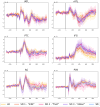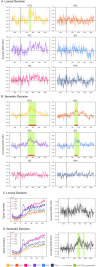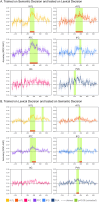Decoding Semantics from Dynamic Brain Activation Patterns: From Trials to Task in EEG/MEG Source Space
- PMID: 38320767
- PMCID: PMC10913025
- DOI: 10.1523/ENEURO.0277-23.2023
Decoding Semantics from Dynamic Brain Activation Patterns: From Trials to Task in EEG/MEG Source Space
Abstract
The temporal dynamics within the semantic brain network and its dependence on stimulus and task parameters are still not well understood. Here, we addressed this by decoding task as well as stimulus information from source-estimated EEG/MEG human data. We presented the same visual word stimuli in a lexical decision (LD) and three semantic decision (SD) tasks. The meanings of the presented words varied across five semantic categories. Source space decoding was applied over time in five ROIs in the left hemisphere (anterior and posterior temporal lobe, inferior frontal gyrus, primary visual areas, and angular gyrus) and one in the right hemisphere (anterior temporal lobe). Task decoding produced sustained significant effects in all ROIs from 50 to 100 ms, both when categorizing tasks with different semantic demands (LD-SD) as well as for similar semantic tasks (SD-SD). In contrast, a semantic word category could only be decoded in lATL, rATL, PTC, and IFG, between 250 and 500 ms. Furthermore, we compared two approaches to source space decoding: conventional ROI-by-ROI decoding and combined-ROI decoding with back-projected activation patterns. The former produced more reliable results for word category decoding while the latter was more informative for task decoding. This indicates that task effects are distributed across the whole semantic network while stimulus effects are more focal. Our results demonstrate that the semantic network is widely distributed but that bilateral anterior temporal lobes together with control regions are particularly relevant for the processing of semantic information.
Keywords: MVPA; decoding; semantic cognition; semantics; task; visual word recognition.
Copyright © 2024 Magnabosco and Hauk.
Conflict of interest statement
The authors declare no competing financial interests.
Figures






Similar articles
-
Task modulation of spatiotemporal dynamics in semantic brain networks: An EEG/MEG study.Neuroimage. 2022 Feb 1;246:118768. doi: 10.1016/j.neuroimage.2021.118768. Epub 2021 Nov 30. Neuroimage. 2022. PMID: 34856376 Free PMC article.
-
Time-Lagged Multidimensional Pattern Connectivity (TL-MDPC): An EEG/MEG pattern transformation based functional connectivity metric.Neuroimage. 2023 Apr 15;270:119958. doi: 10.1016/j.neuroimage.2023.119958. Epub 2023 Feb 21. Neuroimage. 2023. PMID: 36813063 Free PMC article.
-
Early neural activation for lexico-semantic access in the left anterior temporal area analyzed by an fMRI-assisted MEG multidipole method.Neuroimage. 2009 Feb 1;44(3):1093-102. doi: 10.1016/j.neuroimage.2008.10.021. Epub 2008 Nov 5. Neuroimage. 2009. PMID: 19027078
-
The neurocognitive basis of knowledge about object identity and events: dissociations reflect opposing effects of semantic coherence and control.Philos Trans R Soc Lond B Biol Sci. 2020 Feb 3;375(1791):20190300. doi: 10.1098/rstb.2019.0300. Epub 2019 Dec 16. Philos Trans R Soc Lond B Biol Sci. 2020. PMID: 31840592 Free PMC article. Review.
-
A meta-analysis of fMRI studies on Chinese orthographic, phonological, and semantic processing.Neuroimage. 2012 Oct 15;63(1):381-91. doi: 10.1016/j.neuroimage.2012.06.047. Epub 2012 Jul 1. Neuroimage. 2012. PMID: 22759996 Review.
References
-
- Bezsudnova Y, Quinn AJ, Jensen O (2023) Spatiotemporal properties of common semantic categories for words and pictures (p. 2023.09.21.558770). bioRxiv.
MeSH terms
LinkOut - more resources
Full Text Sources
Research Materials
